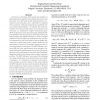Free Online Productivity Tools
i2Speak
i2Symbol
i2OCR
iTex2Img
iWeb2Print
iWeb2Shot
i2Type
iPdf2Split
iPdf2Merge
i2Bopomofo
i2Arabic
i2Style
i2Image
i2PDF
iLatex2Rtf
Sci2ools
CVPR
2000
IEEE
2000
IEEE
A General Method for Errors-in-Variables Problems in Computer Vision
The Errors-in-Variables (EIV) model from statistics is often employed in computer vision thoughonlyrarely under this name. In an EIV model all the measurements are corrupted by noise while the a priori information is captured with a nonlinear constraint among the true (unknown) values of these measurements. To estimate the model parameters and the uncorrupted data, the constraint can be linearized, i.e., embedded in a higher dimensional space. We show that linearization introduces data-dependent (heteroscedastic) noise and propose an iterative procedure, the heteroscedastic EIV (HEIV) estimator to obtain consistent estimates in the most general, multivariate case. Analytical expressions for the covariances of the parameter estimates and corrected data points, a generic method for the enforcement of ancillary constraints arising from the underlying geometry are also given. The HEIV estimator minimizes the first order approximation of the geometric distances between the measurements and...
Computer Vision | CVPR 2000 | Earlier Solution | HEIV Estimator | Nonlinear Constraint | True Data Points | Vision Estimation Tasks |
| Added | 12 Oct 2009 |
| Updated | 12 Oct 2009 |
| Type | Conference |
| Year | 2000 |
| Where | CVPR |
| Authors | Bogdan Matei, Peter Meer |
Comments (0)

